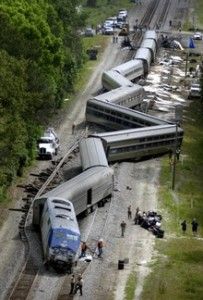Wall Street Journal too nervous about bullet-train ruling
by Chris Reed | September 15, 2014 7:00 am
 Over the weekend, the Wall Street Journal’s editorial page continued its excellent coverage of California issues with an editorial (behind pay wall) about the July 31st appellate court ruling that overturned a trial court ruling essentially blocking concrete steps toward the construction of the state’s nutty bullet-train project. Like just about all of the California media, the WSJ saw the ruling as a big triumph for Gov. Jerry Brown and bullet-train fans:
Over the weekend, the Wall Street Journal’s editorial page continued its excellent coverage of California issues with an editorial (behind pay wall) about the July 31st appellate court ruling that overturned a trial court ruling essentially blocking concrete steps toward the construction of the state’s nutty bullet-train project. Like just about all of the California media, the WSJ saw the ruling as a big triumph for Gov. Jerry Brown and bullet-train fans:
In theory at least, courts and ballot referenda are checks on legislative tyranny. A California appellate court has effectively done away with both by ruling that the legal requirements of a bond measure approved by voters for the state’s bullet train are merely “guidance.” …
Six years ago voters approved a referendum authorizing $9 billion in bonds for high-speed rail construction, including language with stringent “taxpayer protections.” These stipulations were, among other things, that the state high-speed rail authority present a detailed preliminary plan to the legislature identifying funding sources and environmental clearances for the train’s first “usable segment” prior to a bond appropriation.
The legislature in 2012 green-lighted the bonds while ignoring these stipulations. The rail authority had pinpointed merely $6 billion of the estimated $31.5 billion necessary to complete the first 300-mile segment from Merced to San Fernando. Only 30 miles of environmental clearances had been certified.
Last year Sacramento County Superior Court Judge Michael Kenny ruled that the authority “abused its discretion by approving a funding plan that did not comply with the requirements of the law.” But in July Sacramento’s Third Appellate District sanctioned the lawlessness with a decision as impressive for its cognitive dissonance as its legal afflatus.
On the one hand, the court opined that “voters clearly intended to place the Authority in a financial straitjacket by establishing a mandatory multistep process to ensure the financial viability of the project.” But then the judges ruled that the challenge to the legislature’s invalid bond appropriation and authority’s preliminary plan, “however deficient,” was in effect moot.
The court could require the authority to redo its plan, but the judges say that would be unnecessary since the Director of Finance must still approve a rigorous final plan before the authority can/spend/ the bond revenue. In other words, the law’s procedural requirements don’t matter. ….
California’s Supreme Court now has an opportunity to do what the appellate judges did not and order Sacramento to follow the bond language. At stake are the rule of law and democratic governance in the Golden State.
Key provisions of Prop 1A acknowledged by appeals court
I certainly agree that the appellate court ruling was strange in that it seemed to ignore the clear sentiment of Proposition 1A about the strength of taxpayer protections. But I don’t think the WSJ writers read the decision as closely as they should have. The appeals court ruling affirms Kenny’s basic theories about the project being unlawful — it just says he stepped in prematurely[1].
The appeals court that vacated Sacramento Superior Court Judge Michael Kenny’s ruling to block the project did not say that Kenny’s conclusion that the HSRA violated Proposition 1A was wrong. Instead, the decision held that a trial judge had no authority to block construction until the legislature and the High Speed Rail Authority approved a final business plan. “The scope of our decision is quite narrow,” the judges wrote in the first paragraph. The decision went on to reinforce two key protections contained in Proposition 1A—both meant to ensure that the state didn’t spend billions on initial construction only to run out of money before a financially viable train system could be built. Judge Kenny ruled that the state had to identify “sources of funds that were more than theoretically possible” in explaining how it would pay for the project’s $31 billion, 300-mile initial operating segment. He also said that the HSRA had to complete environmental reviews for the entire segment before construction could begin. The appeals court contradicted him on neither point.
The appellate court underscored that the law requires the state to establish “financial viability” for the bullet train’s first segment by adhering to a voter-approved “financial straitjacket.” It said that bond funds could only be spent after a funding plan gained approvals from the state finance department, the Joint Legislative Budget Committee, and an independent financial analyst who certified the plan’s soundness—specifically that if built as planned, the bullet train could operate without a taxpayer subsidy. The appeals court judges also agreed with Judge Kenny that the rail authority had to obtain “all the requisite environmental clearances before construction begins.”
These are shortcomings that Brown … cannot easily finesse. The state has less than $10 billion left from Proposition 1A and from federal stimulus funding. The prospect of obtaining additional federal funding from House majority leader Kevin McCarthy, a Bakersfield Republican and ferocious critic of the project, is virtually nil. And the HSRA reportedly has 10 percent of the necessary environmental clearances in hand—and a long list of lawyers lined up to fight future reviews.
Bullet train cheerleaders may be excited now, but Proposition 1A’s financial safeguards (and California’s budget problems) remain formidable obstacles.
That is from my piece[2] last week for City Journal. The appellate ruling is now seen as a triumph for the bullet train. When the history of this fiasco is written, it will be seen as a devastating blow.
- stepped in prematurely: http://www.city-journal.org/2014/cjc0903cr.html
- my piece: http://www.city-journal.org/2014/cjc0903cr.html
Source URL: https://calwatchdog.com/2014/09/15/wall-street-journal-too-nervous-about-bullet-train-ruling/